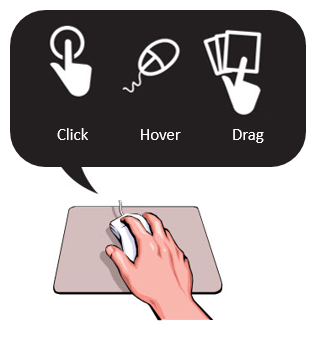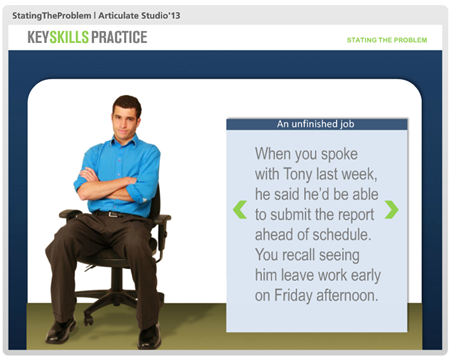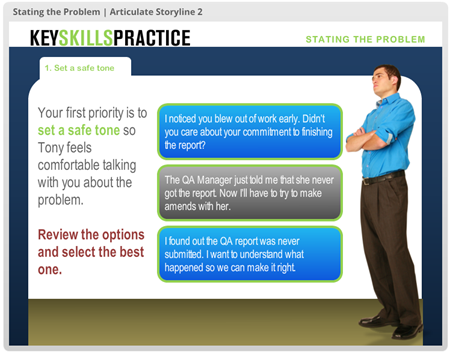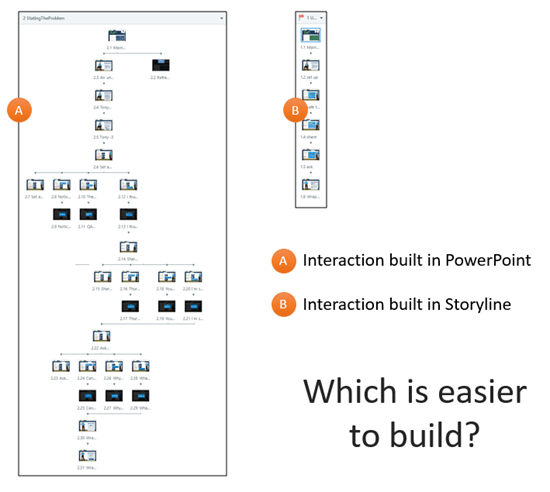Thank you for this thought provoking post. I agree that PowerPoint is the best of its kind but do disagree with the time consuming part. I would have agreed with this once, but with The Office Mix add-on making your PowerPoint interactive is easy and straight forward. I like your post as it does make the reader question how they use software. I think this kind of post should be made of iMovie, Evernote, an some of the other big software packages that need to have their place in their respective sectors questioned and re-evaluated. Software can be great if we use it well. I think though Office Mix is a game changer for your post but this is just my opinion.
Why PowerPoint Isn’t the Right Choice for Interactive E-Learning
December 8th, 2015
If you follow this blog then you know that I’m a big fan of PowerPoint. In fact, I think it’s one of the single best applications out there. And with some practice and creativity, there’s not much you can’t do to create engaging multimedia.
But is PowerPoint the best option if you want to create interactive elearning?
Here’s What Makes PowerPoint Special
Just so you know that this isn’t just another trendy PowerPoint bashing post, I’m starting with some of the cool things you can do with PowerPoint. Here’s a sampling from some of my previous blog posts:
- Edit Free Vector Graphics in PowerPoint
- Top PowerPoint Tips & Tricks
- Create Illustrated Characters in PowerPoint
- Here’s Why PowerPoint Doesn’t Suck
- Create Custom Stock Images in PowerPoint
- 3 PowerPoint Shortcuts
- Dozens of PowerPoint Tips
PowerPoint is a great multimedia application. But it’s not necessarily a great application if you regularly build interactive elearning.
Interactive E-Learning 101
Let’s consider the basics of interactivity and then see where PowerPoint falls short. Essentially there are three types of onscreen interactions: click, hover, and drag. Data entry (such as adding a name) is an additional form of interactivity if you build a course using variables.

Which of those types of interactions can you build with PowerPoint? For the most part, you’re limited to click-and-reveal interactions. Thus, you only have a third of the interaction types available and no programming control for more advanced capability.
Here’s Why PowerPoint Fails at Interactive E-Learning
Below are two interactive scenario examples. One is built in PowerPoint and the other in an application that better supports interactive authoring. Essentially, the scenarios are the same. The big difference is in the production process and time it takes create the interactions.
Here’s the interactive scenario built in PowerPoint.

It works. However, what did it take to build? The PowerPoint interaction includes 31 slides. That’s for only one of the interactive scenarios. If I built out all 6 scenarios, I’d have to add an additional 145 slides and hundreds of individual objects and hyperlinks.
Here’s the same interactive scenario rebuilt in Storyline.

The Storyline version only has 5 slides and it includes a lot more subtle interactive features, like button hovers and visited states. If I wanted to include all 6 scenarios, I’d only add 18 additional slides.

The image above demonstrates the difference between the PowerPoint and Storyline versions of the same interaction. As you can see, the PowerPoint version requires a lot more effort. The Storyline version is much more streamlined and easier to manage.
In fact, if I built this scenario from scratch rather than importing the PowerPoint file like I did for the demo, I’d probably get each interaction to 3 slides. And since the slides are generally the same, I only need to build one slide with three feedback options and reuse them. Not considering the content, building the structure for the interactive scenario would only take a few minutes. That’s not the case with PowerPoint which would take longer and become progressively more challenging to manage as the slide count would increase dramatically.
The other benefit is that the Storyline version of the file can be saved as a template and easily reused for future scenarios. That’s a big time saver. And time is money.
So what’s the point?
- PowerPoint Has Limited Interactions. For the most part, you’re limited to click-and-reveal interactions. There’s no drag-and-drop or button rollovers. Try to create a simple visited state for a button clicked. You can’t. And forgot about adding data entry or variables to build more sophisticated interactive elearning.
- Building Interactions in PowerPoint is Time Consuming. Sure, you can build interactive elements in PowerPoint. The example above demonstrates that. However, building interactive elearning with PowerPoint will cost a lot more time and starts to get messy after a few slides.
- Interactions in PowerPoint Get Progressively More Complicated. Interactions are a combination of hyperlinks to slides. For example, a five tab interaction requires six slides: the main slide and one for each tab. Want to build something more complex, like an interactive scenario? Your slide count increases exponentially; and the structure and maintenance of the course gets overly complicated. Whatever money you think you’ve saved in software you’ve easily spent in authoring. And each subsequent project adds to the cost.
As I stated earlier and throughout this blog, PowerPoint’s a great multimedia application. But if you want to build interactive elearning courses, it’s not the best option. The truth is that you will be saving hundreds (if not thousands) of hours building elearning courses using a tool better suited for interactive elearning.
Of course, if you do freelance consulting and bill by the hour, then it makes sense to stick with PowerPoint. If you don’t, then it’s time to move beyond it for your interactive elearning. You won’t be sorry.
Events
- Everyday. Check out the weekly training webinars to learn more about Rise, Storyline, and instructional design.
Free E-Learning Resources
 |
 |
 |
|
Want to learn more? Check out these articles and free resources in the community. |
Here’s a great job board for e-learning, instructional design, and training jobs |
Participate in the weekly e-learning challenges to sharpen your skills |
 |
 |
 |
|
Get your free PowerPoint templates and free graphics & stock images. |
Lots of cool e-learning examples to check out and find inspiration. |
Getting Started? This e-learning 101 series and the free e-books will help. |
7 responses to “Why PowerPoint Isn’t the Right Choice for Interactive E-Learning”
I normally don’t weigh in on these discussions… 🙂
We’ve been an Articulate instructional design/course development company for a little over a decade now (Studio and early adopters of Storyline) and our work is with Fortune 500/Federal Government accounts. Articulate tools are amazing and we owe them our living! We produce four or five modules a month and we use both tools every day in our company.
Storyline undoubtedly is better for small, interactive training modules where hover, drag-and-drop, data entry, custom triggers, etc. are awesome and needed for advanced interactivity. Then there’s better video handling, layers, and other benefits. This is why we use Storyline for some projects.
Studio, however, is still 70% of our work.
Production Time
One of the significant reasons…wait for it…is production time. We have about five years of detailed employee logs for over one hundred Studio and Storyline modules. For roughly equivalent courses, Storyline modules take us–very consistently–just shy of 25% longer. We quote and charge our clients accordingly. Synchronization of animation/professional voiceover, software responsiveness, in-tool graphic development, additional coding time on the SL side, are maybe some of the reasons.
Interaction is Maybe Not the Only Measure of Awesomeness
“Click Next” model. Really? Storyline is better for small advanced interactions, but good interaction IS completely possible with Studio and there’s a LOT more that can be done in terms of animation…especially in a rigorous production environment.
We recently had a $24B revenue corporate client tell us our Studio course was, “gorgeous and effective.” We had a federal government client tell us last month that our Storyline interaction was “amazing.” Both had a lot of animation and interactivity.
Long live Articulate! (You know, Storyline and PowerPoint-based Studio.)
p.s. Tom, if you comment on this rare-for-us-post you should try to be kind because you are kind of a folk hero in our organization and have been for many years.
All Good points on advanced interaction differences, Tom.
p.s. I know some smaller organizations can’t necessarily budget for both, but we have really found Studio and Storyline to be best-of-class in their individual categories of PowerPoint conversion and independent eLearning platform and it’s been a very successful strategy for us to wield them as needed for what they’re good at.
Wow Thats Amazing post Thanks For sharing Keep It Up…
We got involved in a grant and some of the funds will support us adding Story Line 2 to our toolbox for development. With that said, I expect we will do a lot of ‘new’ and interactive modules with the capabilities within the new software.
However, when we need to do a rapid update to anything already in use – Studio will be the tool – also with Studio I can very quickly make some simple cosmetic changes to a package and republish an updated version without a lot of time in development. In the ideal/best world, you get to have both!









0
comments